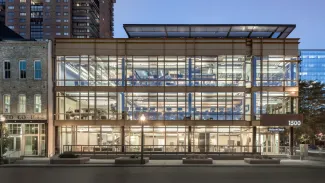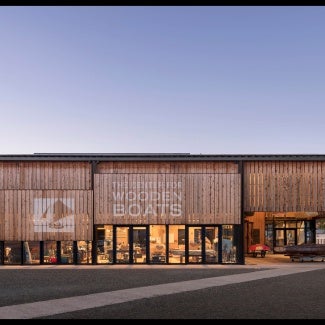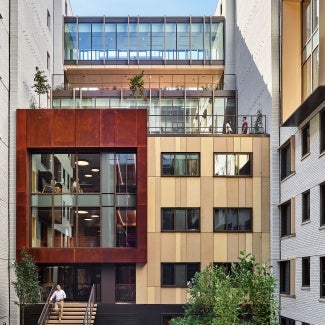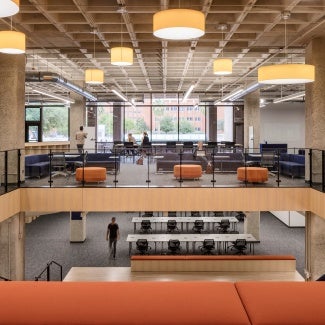GoSpotCheck Headquarters
The award-winning contemporary architecture of the GoSpotCheck Headquarters in Denver remedies a critical gap in the city’s streetscape and contributes to the richness and walkability of the downtown community.

Project highlights: GoSpotCheck Headquarters
- Architect: Tryba Architects
- Owner: Seed Acquisitions, LLC
- Location: Denver
Transforming a previously underutilized corner in Denver’s Lower Downtown neighborhood, the new headquarters for GoSpotCheck, an analytics and business intelligence company, remedies a critical gap in the city’s streetscape. The project is a 16,000-square-foot expansion of the historic Rocky Mountain Seed Building, which replaces a drab surface parking lot and contributes to the richness and walkability of Denver’s downtown community.
GoSpotCheck was founded in Denver in 2011 as a small startup, but the staff quickly blossomed to 60 employees. The staff has grown even more in the intervening years, making GoSpotCheck’s headquarters in the historic building feel cramped. By expanding the building, the design team has ensured that the local startup can retain its prominent position on Market Street.
For its initial approach, the design team examined all aspects of the neighborhood, exploring the diversity of scales and material choices, from brick and heavy timber commercial storefronts from the 1880s to the city’s newest glass and steel high-rise office towers. The expansion draws on the proportions and scale of the Rocky Mountain Seed Building and its peers in the neighborhood, but instead of masonry employs steel and glass construction. The expansion reveals the building’s inner workings, reflecting the ethos of a startup tech company and completing the streetscape.
The new structure is among the first of its kind in the neighborhood, serving as a beacon and marking an important gateway from the south and east. Recycled steel and raw glulam beams as well as tongue-and-groove wood decking reveal what is typically hidden by masonry to passersby. A custom-designed steel curtainwall system comprises the exterior and includes aluminum-clad wood windows. All eight sections of the curtainwall were fabricated off-site, shortening the construction schedule and offering a high level of attention to the project’s defining element.
Inside, the addition encourages engagement among employees and the surrounding public realm. A wide central stair draws natural light into the open floor plans while boosting circulation between the upper and lower levels. At the top-floor mezzanine, an L-shaped deck offers views of the neighborhood and the Front Range of the Rocky Mountains. The ground level includes coworking and event space, which facilitate social engagement with direct visual connections to the bustle of Market Street.
An intensive and iterative collaboration with the developer, community, and the Lower Downtown Design Review Board introduced the new building to the neighborhood. The process is reflective of the building’s commitment to the scale and proportion of its neighbors while also demonstrating how diverse architecture can thrive in historic districts.
Project team & Jury
General Contractor: Hyder Construction
Engineer - Civil: Wilson & Company
Engineer - MEP: WSP
Engineer - Structural: Monroe & Newell Engineers, Inc.
Consultant - Acoustics: Geiler Associates
Consultant - Interiors: Tryba Architects (FF&E provided by Pear)
Consultant - Specifications: Architectural Specifications
Consultant - Code & Life Safety: Advanced Consulting Engineers, Inc.
Consultant - Accessibility: Colorado Code Consulting, LLC
Ashley Wilson, FAIA, Chair, Ashley Wilson Architect, Alexandria, Va.
Jose Leo Arango, Assoc. AIA, EYP, District of Columbia
Randall Deutsch, FAIA, University of Illinois at Urbana-Champaign School of Architecture, Champaign, Ill.
Gabriel Ignacio Dziekiewicz, AIA, DesignBridge, Chicago
Teresa Jan, AIA, Multistudio, San Francisco
Luis Nieves-Ruiz, East Central Florida, Regional Planning Council, Orlando, Fla.
Zakiya Wiggins, AIA, LS3P, Raleigh, N.C.
The 2023 Architecture program celebrates the best contemporary architecture regardless of budget, size, style, or type. These stunning projects show the world the range of outstanding work architects create and highlight the many ways buildings and spaces can improve our lives.
Sixteen projects showcase the best contemporary architecture.











